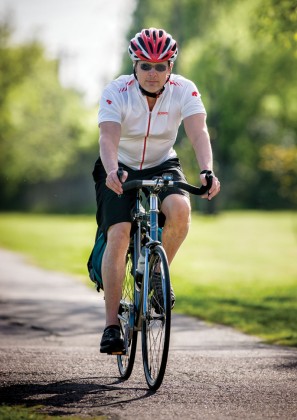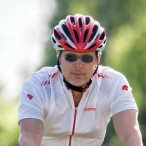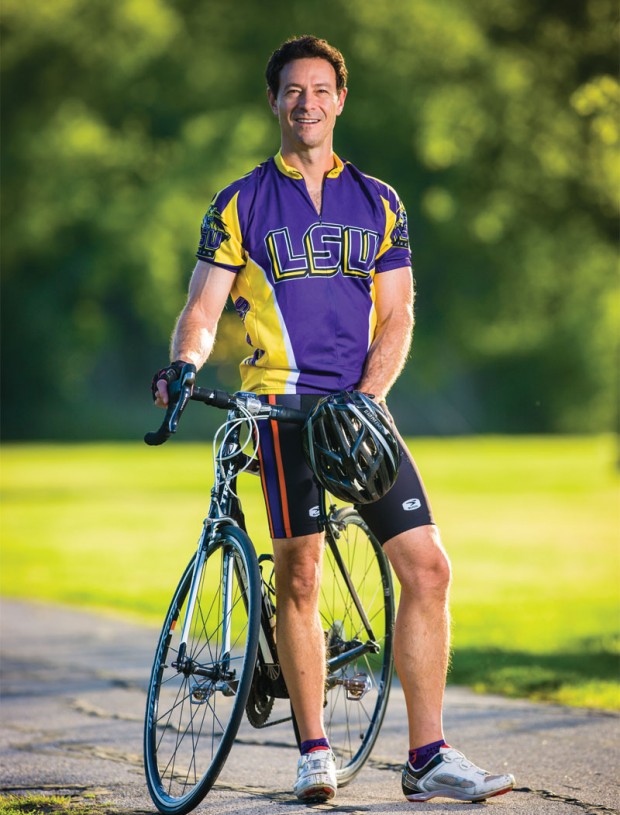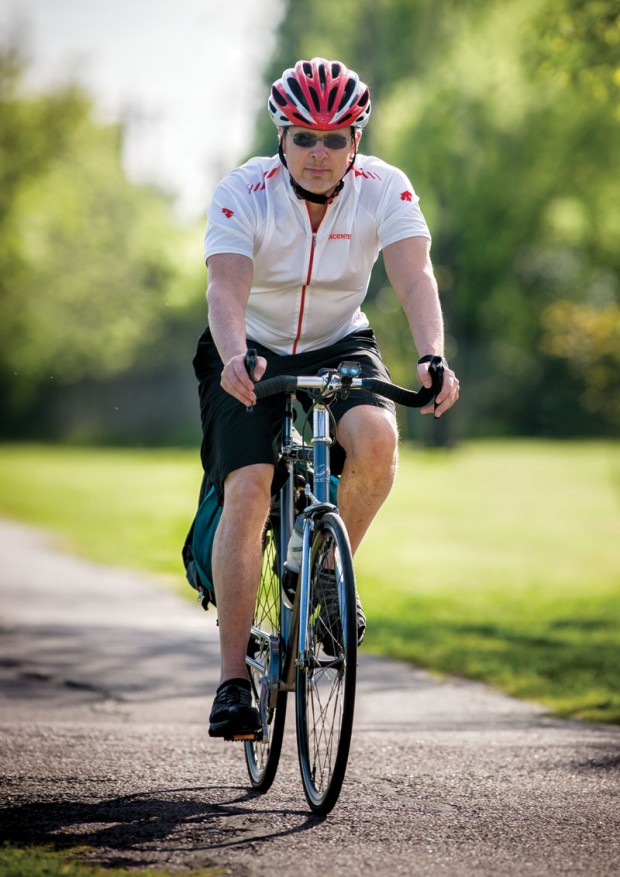Let’s Ride
Bicycling in Houston

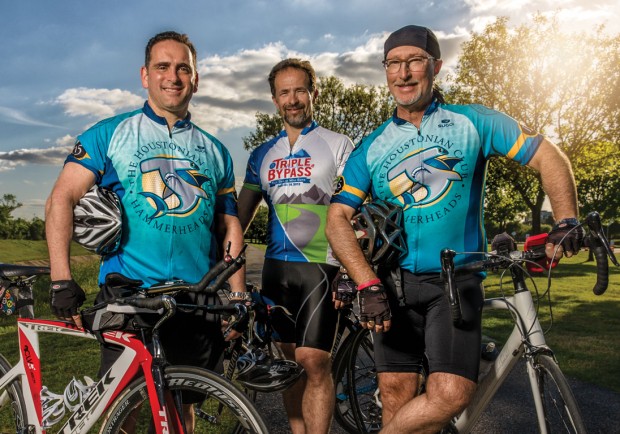
Darrell Rosenthal, wealth advisor, Igor Cherches, neurologist, and Mark Mucasey, architect, (from left) are all avid cyclists. (Photo: hartphoto.com)
What’s not to like about cycling? When you bike rather than drive, you cut down on pollution and traffic.
While you are doing that, you are exercising in a particularly beneficial way, one that’s easy on the joints and burns a relatively large number of calories, about 500 per hour even at moderate speeds.
And you can get places while you exercise. Jeff Horowitz, a 55-year-old attorney, commutes to work from West U to downtown, an eight-mile ride. Igor Cherches, a neurologist from Bellaire, bikes to work five miles on the Brays Bayou trail, “a great place to start your day and get your thoughts together,” he said. Regina Garcia, who bikes about three miles to El Meson, the Rice Village restaurant she and her husband Pedro own, reports that it takes about 15 minutes, the same amount of time it would take to drive.
And biking is just fun, in a way that brings back childhood memories. “I rode my bike to school until I could drive,” Horowitz remembered. “When I was a teenager, we’d ride on Brays Bayou all the way to Hermann Park. At 14, I rode my bike to my first job, at the Astrodome.” (He sold peanuts.)
“As a kid, your bike was your car,” remembered Tyler Garcia, who grew up in New Jersey. Still an avid cyclist, Garcia, a counselor at Houston Community College, is one of the volunteer administrators of HTX Bike Social, a Facebook page with over 1,900 members, which lists group rides and cycle-friendly events happening around Houston.
Cycling can be dangerous, a fact brought home recently when five cyclists in Houston died in a single month. According to surveys, one of the most common reasons people give for not biking is concern about safety. And Houston, in particular, does not currently have a good record. According to The 2014 Bicycling and Walking in the United States Benchmark Report, done by the Alliance for Biking & Walking, out of the 52 largest cities in the U.S., Houston ranks 37th when it comes to bicyclist/pedestrian fatality rates.
Many factors account for this, from the design of our streets to our drunk-driving laws to how educated both drivers and cyclists are about safety. The good news for cyclists is that the City of Houston, in conjunction with a number of grassroots organizations such as BikeHouston and the Houston Parks Board, is working to make Houston more bike-friendly. The Bayou Greenways 2020 project is on schedule to create a network of 150 miles of hike and bike trails along the city’s bayous, connecting the city’s parks, with the Brown Foundation, Inc. and the Wortham Foundation most recently pledging grants, $2 million and $1.6 million respectively, to the project.
And for the first time in 20 years, the city has implemented a Bicycle Master Plan, which looks to establish safe bike routes that people can use to get all over the city. In March, it opened the first protected bike lane in Houston, crossing downtown on Lamar, from Sam Houston Park to Discovery Green. This bright-green lane, separated from cars by humps, allows cyclists, going in either direction, to get across downtown Houston more safely.
So, what do you need to know to bike in Houston?
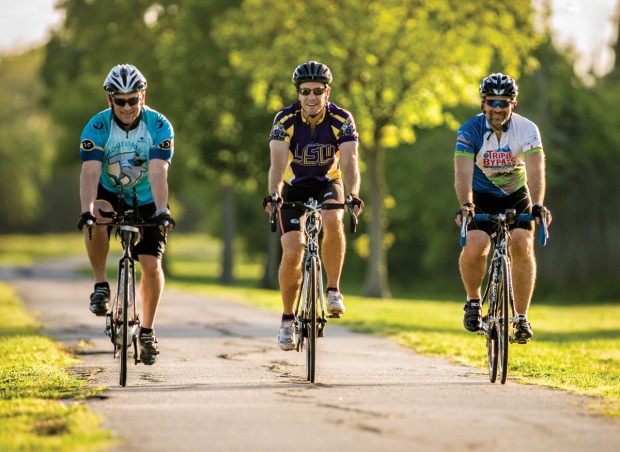
“Cycling is definitely social,” said Brad Patt, (center) riding with Darrell Rosenthal (left) and Igor Cherches. “The MS 150 is not a race; it’s a ride.” (Photo: hartphoto.com)
First, know there are different types of bike-riding, from mountain-biking on the trails in Memorial Park to “training rides” on super-light road bikes over long distances, most often outside of Houston proper, often to get ready for events such as the BP MS 150, the two-day bike ride in April, from Houston to Austin, that raises money for the National MS Society. And there are more sedate bike rides, usually on sturdier, slower bikes, even on old-fashioned beach cruisers, the type of bike Pee-wee Herman rode, just for fun on the city’s ever-growing system of street and bayou trails.
If you want to try out cycling before buying a bike, you can use Houston B-Cycle, the city’s bike-sharing program, or rent a bike for the day from a bike shop. Also, yes, you can bring that old bike that’s been sitting out in the garage to a bike shop to see if it’s worth a tune-up. Often, especially if you’re just starting out, it is.
There’s no reason you can’t do several types of cycling. Roy Camberg, a River Oaks attorney and triathlete, regularly goes for training rides on his triathlon bike (specially designed to take the stress off certain muscles in the rider’s legs, to save them for the triathlon’s final event, a run) and also rides Houston’s bike trails, using mountain bikes, with his wife, Ellie Beard, on the weekends.
Second, bike shops often sponsor regular group rides, for all levels of experience. These rides can be found on the stores’ websites and also often on the website for the nonprofit BikeHouston. Regina Garcia is a founding board member of BikeHouston. She is also a certified bike instructor, through the League of American Bicyclists, one of approximately 70 in Houston who teach one-day classes on how to cycle safely on city streets and in groups.
Her safety tips, and those of other experienced cyclists, are not always what you might expect. For instance, Garcia feels safe riding at night, pointing out there is often less traffic. “Of course, have a good set of lights on your bike,” she said, “but it’s also easier for you to see cars, particularly coming from behind, because they have their lights on.” And while cyclists are, of course, cautious about cars (“They weigh tons, you weigh pounds,” said one cyclist) and potholes, they are also concerned about expansion joints, spaces between the slabs of concrete of the road that allow the concrete to expand and contract without cracking. An expansion joint can catch the tire of a bicycle, sending its rider over the handlebars.
Many cyclists prefer riding in groups. “A group becomes an entity in itself, like a school of fish,” said Darrell Rosenthal, a member, along with Jeff Horowitz, of The Kvetchers, a group named after the Yiddish word for “complain.” “In a group, you are more visible and cars treat you with more respect,” Rosenthal said. And if you have an injury or a problem with your bike, you’re not alone.
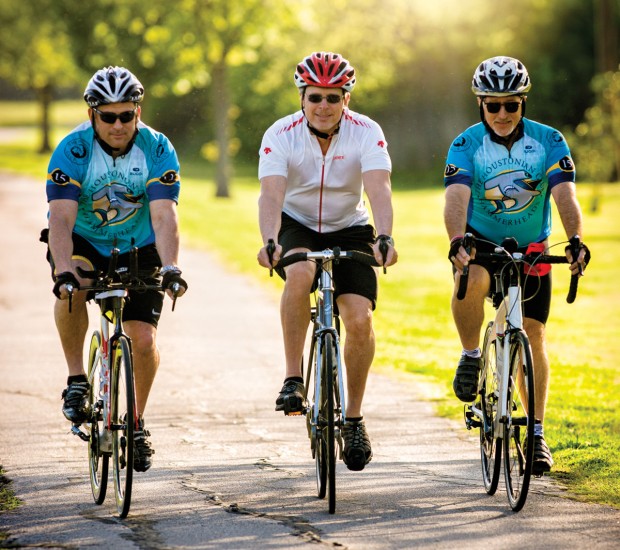
Darrell Rosenthal (left), riding with Jeff Horowitz (middle) and Mark Mucasey, says, "In a group, you are more visible, and cars treat you with respect." (Photo: hartphoto.com)
Plus, there’s the social aspect. “When you are riding with 20 guys on a Sunday morning, there’s a certain rhythm: You talk to one guy, then the group shifts and you’re talking to another guy. It’s a really relaxed way to socialize,” said Horowitz.
The camaraderie of biking with a group can be quite touching. When one of The Kvetchers stopped showing up for the group’s rides, though he had been training for the upcoming MS 150, other members discovered that his father had died, and, in keeping with Jewish tradition, the man had been going to synagogue every day to pray, a practice he would do for a full year.
“He told us that he wouldn’t be able to do the MS 150 that year,” said Mark Mucasey, an architect from Bellaire. “We told him we would make sure we always had at least 10 men at every bike ride [the minimum necessary to form a minyan and hold a service]. For four months and for each day of the MS 150, we did this with him for his father so he could ride with us.”
There are some things to know when riding in a group: Pass on the left, saying, “On your left,” if you are going to be close, announce when you are slowing or stopping, and call out hazards, such as pot holes. Tyler Lopez recommends beginners bring a tube (easy to fold and carry) that fits your bike’s tire in case you get a flat. Though you might not yet know how to fix it yourself or have the tools, other cyclists are usually happy to help.
When looking for a bike ride to join, bear in mind the different types. Online listings make clear what to expect by listing the speed of the ride: 18 miles per hour and above is fast, 14-16 is moderate, and 12 is mellow. Some gung-ho rides will specify that they are a “drop ride,” meaning that, if you can’t keep up, they will leave you behind. The description of one recent casual ride, on the other hand, directed you to “leave your Lycra at home.”
Training rides are long-distance (30-70 miles) rides done on road bikes. These usually take place on routes outside of town, such as in Fulshear or Chappell Hill. Training riders look for routes where they can go fast, sometimes over 20 mph, safely for long distances. “You really need to ride distance to get ready for the MS 150,” said Brad Patt, a 50-year-old plastic surgeon.
“My favorite routes are from Katy to Bellville, around Montgomery/Lake Conroe and Coldspring on Lake Livingston,” said Cherches, who has cycled for about 20 years.
There are organized bike rides, supporting various charities, every weekend, especially from January until April, before the MS 150. These events are referred to as “supported rides,” since they feature routes closed to traffic, rest stations with water and snacks, bike mechanics and SAG (support and gear) wagons, vehicles to transport riders stymied by injuries, bike problems or just plain fatigue.
The more laid-back social rides posted on HTX Bike Social run the gamut. There are women-only rides, family-friendly rides, night-time rides, even rides with a group called “The Rusty Riders,” for owners of vintage beach cruisers. These rides, set up by volunteers, might feature a stop at the midpoint of the ride to see an art exhibit and then end at a restaurant for dinner.
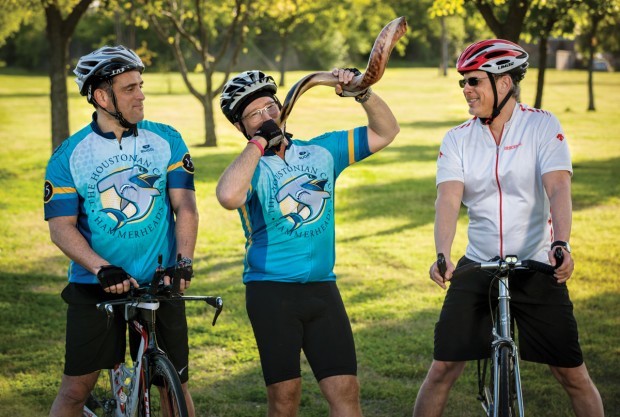
The Kvetchers cycling group, including (from left) Darrell Rosenthal, Mark Mucasey and Jeff Horowitz, use a shofar, a religious musical instrument made from a ram’s horn, to start their morning rides and celebrate Rosh Hashanah, the Jewish New Year, during September. (Photo: hartphoto.com)
When it comes to planning your own routes, there’s more to it than hopping on your bike and going. Garcia goes over how to plan your routes in her class. “You wouldn’t do the same route as you would driving,” she said. If the most direct route would take a traffic-heavy street, such as Kirby, “a good rule of thumb is to look one street over,” she said. When she first planned her commute to work, she rode it on off-times, to check it out, before she did it on a weekday morning.
Mark Mucasey plans routes for The Kvetchers. One route had them going over the Fred Hartman Bridge, a suspension bridge over the Ship Channel in Baytown. His routes always feature options: While the group is together for most of the ride, as they near the end, a rider can choose to go a shorter route (shaving 10 miles off the trip) or a longer way, with both routes ending at the same destination. When riding in town, that would be a restaurant for breakfast that is no more than three miles from anyone’s home. When riding out of the city, it’s a good barbecue restaurant.
Mike Skelly’s favorite in-town ride goes from Market Square, east on Buffalo Bayou to Lockwood, then down Navigation to the Ship Channel and turning basin, then back up Brays Bayou to Columbia Tap and back downtown.
Skelly, who is involved with both BikeHouston and the Houston Parks Board, began riding around the bayous with friends years ago and leads monthly tours, through BikeHouston, of some of the bayou trails. “It’s a great way to explore the city and make friends,” he said.
How to drive safely with cyclists
My husband and I were stopped at a light on Shepherd. It was rush hour, there was construction, and a cyclist pulled up alongside us, dwarfed by the cars and trucks.
“Man,” said my husband, an avid cyclist himself. “He’s as fragile as an egg out there, isn’t he?”
When it comes to crashes, “we don’t call them ‘accidents,’” said Michael Payne, executive director of BikeHouston, “because they are usually the result of someone not following the rules.” Payne estimated that about two-thirds of all bike fatalities are the result of a motorist’s mistake and one-third the cyclist’s.
Here’s advice from both BikeHouston and the National Highway Traffic Safety Administration (NHTSA) about how to protect the safety of fellow road users, including cyclists:
Don’t speed.
Don’t drive under the influence.
Don’t use your cell phone or otherwise distract yourself. According to the latest data available from the NHTSA, nationwide in 2013, 3,154 people were killed and an estimated 424,000 people were injured in crashes involving distracted drivers.
And not using your cell phone means not using even a hands-free system and not texting even when you are stopped at a light. Multiple studies have shown that using a cell phone while driving leaves the driver as impaired as being drunk, and hands-free systems do not lessen that impairment. And texting is worse. According to A Deadly Wandering, a book by New York Times reporter Matt Richtel, it can take drivers 10 to 20 seconds to reorient themselves to what’s going on around them after they’ve finished sending a text, which is a lot of time to be moving when you haven’t registered that cyclist in front of you.
Give cyclists as much room as possible. In May 2013, the City of Houston passed the Safe Passing Ordinance, which requires motor vehicles to keep a distance of more than three feet when passing cyclists and other “vulnerable road users,” such as pedestrians, and at least six feet when trailing them.
Take care not to turn into the path of a cyclist, including when you are taking a right on red.
Watch for all types of road users, including bikes, when parking, backing up and pulling out, and look out for passing traffic before opening your car door.
Igor Cherches’ favorite routes:
From Katy to Bellville: Start on Highway 90 going west, go north on 359, turn left (west) on 529. Right after the Brazos River, turn left (south) on 331 and then right (west) on Coshatte Road (“Quite hilly and has great pavement,” said Cherches), which will bring you back to 529 and Bellville and then head back to Katy. (Round trip: 70 miles.)
Lake Conroe Trip: Start at Montgomery High School, go west on 105, turn right (north) on 1486 and go all the way to Richards. For a 46-mile ride, turn right (east) on 149 and right (west) on 105 to get back to the high school. For a 70-mile ride, take 149 from Richards to Anderson, instead, and come back on 2819. “That adds quite a few hills and is quite scenic,” said Cherches.
Coldspring Trip: Start at Coldspring-Oakhurst High School, go a short distance north on 150 and go left (north) on 156, turn right on 224, which is very hilly. Take that back to 156. From 156, take 2025 South and turn left (east) on 2666, then right on 150, then left on 222 North to 3128 and then turn left on 1514 back to Coldspring.
For more on Houston cycling
Visithoustontexas.com - This page of the Greater Houston Convention & Visitors Bureau gives links and information about Houston B-Cycle, the city’s bike-share program, and lists several scenic bike routes through Houston neighborhoods.
bikehouston.org - The BikeHouston website lists clinics, workshops, events and group rides taking place around town, including its own monthly bike tour of the bayou trails, led by advisory board member and former West U resident Mike Skelly.
These apps help cyclists plot their routes, including seeing routes other people have devised:
HTX Bike Social, a Facebook group, lists social bike rides happening around Houston.
Bikeed.org contains the free online portion of the cycling classes offered by the League of American Bicyclists, sponsored by the City of Houston.
With its Bayou Greenways website, the Houston Parks Board provides the latest information on and interactive maps of the interlinking hiking and biking trails and park system being developed along Houston’s bayous.
You can also find out more about the board, including info about its upcoming annual luncheon on October 20, at houstonparksboard.org.
The Rails to Trails Conservancy, a national organization dedicated to turning unused railroad beds into trails, has created TrailLink, an interactive map to locate its trails, including several in Houston.
Many group rides start from local bike shops, including Bike Barn, Bicycle World and West End Bikes.
The National Multiple Sclerosis website for the MS 150 has much information, including a full calendar of recommended supported rides to prepare for the MS 150 as well as a schedule of local League of American Cyclist classes and a 16-week training guide.
Want more buzz like this? Sign up for our Morning Buzz emails.
To leave a comment, please log in or create an account with The Buzz Magazines, Disqus, Facebook, or Twitter. Or you may post as a guest.



